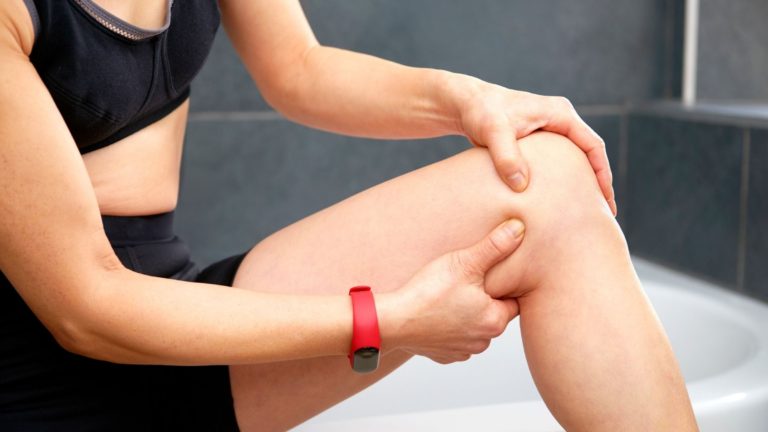
How to Prevent Stress Fractures from High-Impact Workouts

Get full access to Outside Learn, our online education hub featuring in-depth fitness and nutrition courses and more than 2,000 instructional videos when you
sign up for Outside+.
Warmer weather brings more outdoor workout opportunities — from running, to outdoor HIIT and even obstacle course racing. While enjoying the fresh air, many fitness enthusiasts find new energy. It’s a great way to revamp your routine, but that energy can also lead to harder and longer workouts without even noticing how time flies.
The newfound energy and motivation keep us going — that is, until shin and foot pain crop up out of nowhere. At first, most will assume the discomfort is from shin splints or plantar fasciitis, until it doesn’t go away. Often, the culprit for this type of pain is a stress fracture. This may seem surprising for fitness enthusiasts, but it’s no surprise for healthcare providers. Stress fractures account for almost 20 percent of injuries seen in orthopedic clinics, and most of the patients are young, active women!
While stress fractures may sideline your fitness plans for months, you can prevent stress fractures in many cases. Keeping yourself in the fitness game is easy with just a few fitness and nutrition tweaks. With a few simple strategies to prevent stress fractures, you’ll be all set.
Plan It Out
The number one reason for such sharp rises in summertime stress fractures is doing too much too fast. But what is too much too fast? Exercise science says don’t increase your routine’s intensity by more than 10 percent per week. If you’ve ever tried to measure that, confusion probably followed. So, the rule is easy to say, but quite complex to enact.
Your plan will depend on what you want to do and where you’re starting. Here are some general guidelines to help:
Exercise Plan: Integrating Running or High-Impact Activity
If you want to run or do high-impact activity, carve out 40 minutes on two to three non-consecutive days in the week. The first 10 minutes and last 10 minutes are for your warm-up and cool-down routines.
Use the following table to guide your progression into high-impact fitness. Complete each workout at least three times before progressing to the workout for the next week. Listen to your body; allow yourself permission to repeat workouts more than 3 times before progressing to the next phase if you feel fatigued or sore.
Here’s how to build up to a full 30 minutes of moderate- to high-intensity outdoor running or aerobic activity safely.
| Week | Low-Impact Interval | High-Impact Interval | Repeat |
| 1 | 4 minutes | 1 minute | 5 times |
| 2 | 3 mintues | 2 minutes | 5 times |
| 3 | 2 minutes | 3 minutes | 5 times |
| 4 | 1 minute | 4 minutes | 5 times |
By week five, you’ll be ready to cut out the low-impact intervals and go for 30 continuous minutes of moderate- to high-intensity work.
Rest Right After HIIT Workouts
Now that you’re ready for the next level of moderate- to high-intensity interval training, your body needs more recovery. Plan for at least 72 hours to recover between HIIT workouts.
Recovery doesn’t need to be a rest day. Instead, plan lower-impact activities like resistance training, the elliptical, biking, swimming, yoga, Pilates, stretching or mobility work.
Nutrition Audit
Bone quality and density depend more on what you eat than what type of workouts you do. Calcium and vitamin D are the essential must-have foundations.
Nutrition Audit: Calcium
“Drink your milk to build strong bones.” You’ve probably heard this advice before, and it’s true that two servings of dairy a day provides a great calcium base. The average woman needs 1,000 mg of calcium each day.
As we age, however, our digestion changes. This leads many to eliminate milk and sometimes dairy altogether. If milk is not on the menu, how are women supposed to get enough calcium to build strong bones? There are three great options: other food choices with naturally high calcium, fortified foods, and supplements.
Calcium: Alternative Food Choices
If dairy isn’t for you, other foods high in calcium include soy (like tofu and edamame), salmon, beans, chickpeas, lentils, broccoli, spinach, kale, figs, oranges and almonds.
If getting at least a few of these foods in each day doesn’t appeal to your taste, try fortified foods. Most alternative milks, yogurts, orange juice, and some cereals include added calcium. Amounts vary by manufacturer, so check the label to see how much calcium is included.
If food options don’t provide enough calcium, supplements may help bridge the gap. Calcium supplements come in two major forms: Calcium carbonate and calcium citrate. Calcium carbonate should be taken with food so the body can absorb it. Calcium citrate, however, can be taken on an empty stomach. If you also use iron or zinc supplements, plan your calcium supplement for a different time of day; while iron and zinc are essential for your health, taking them at the same time decreases the body’s ability to absorb calcium.
Nutrition Audit: Vitamin D
Our bodies require vitamin D to absorb calcium. Without enough vitamin D, the body can’t direct calcium to build bone. The average woman needs 600 IU of vitamin D per day, but women often struggle to get enough vitamin D for two reasons:
Reason 1: The top vitamin D food sources may not suit our tastes. The top vitamin D food sources are cod liver oil, salmon, tuna, sardines, dairy, and milk or orange juice fortified with vitamin D.
Reason 2: Vitamin D is a fat-soluble vitamin. For several decades, marketing pushed fat-free foods as top choices for lean physiques. Even though science has shown us that fat-free products don’t automatically create lean physiques, these products are still leading choices.
While fat free dairy products or orange juice may include vitamin D, the body cannot absorb the vitamin D well without the fat. If your only vitamin D source comes from fat-free foods, you may need to add fats like flax, chia, or nuts so your body can absorb the necessary vitamin D.
These shortcomings in natural vitamin D sources lead to either obtaining vitamin D from sunlight, or supplementation.
More is not better, however, as most supplements suggest having your doctor monitor your vitamin D blood levels to see how your body absorbs the vitamin; this can help you figure out your individual optimal supplement dose.
Partner With Your Doctor
While vitamin D monitoring provides one important element for optimal bone health, there are two more stress fracture prevention conversations to have with your doctor: thyroid levels and your menstrual cycle.
One out of every eight women experiences a thyroid disorder, and only 60 percent of those with thyroid conditions are aware they have a condition. Hyperthyroidism, or too much of certain thyroid hormones, will break down bone; lower bone density increases risk of stress fractures.
Your monthly cycle is also a sign of your body’s bone health. Cycle irregularities, missing periods, or loss of periods are associated with up to a 50 percent increased risk in stress fractures. Your monthly cycle is sending you messages, which you and your doctor can interpret for optimal bone health.
Next Steps
As you rev up your summer workouts, use the above exercise, nutrition, and doctor conversation starters to stay away from the fitness stress fracture sidelines.
Learn something that would help a friend? Bookmark and share this article to help your fitness friends too!
Published at Wed, 18 May 2022 08:43:21 -0700






